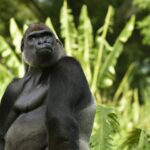.jpg)
Gorillas, the majestic creatures of the African forests, have long mesmerized humankind. These incredible mammals possess a unique mix of strength and intelligence. Plus, they display intricate social behaviors and strong emotional connections within their families.
Led by an alpha male, the silverback, they form close-knit units and show remarkable empathy towards their fellow tribe members. A poignant story from 1976 highlights this, when primatologist Dian Fossey encountered a young gorilla, Digit, brutally killed by poachers. This sparked worldwide outrage and renewed the need to conserve gorillas and their habitats.
The world of gorillas continues to captivate scientists and wildlife admirers alike. Through research and observation, we uncover more about these extraordinary mammals and work to preserve them for future generations. We also gain invaluable insights into our shared history with gorillas and discover profound connections that transcend mere classification.
Key Takeaways
- Gorillas are indeed mammals.
- Mammals are a group of animals that have certain characteristics, such as being warm-blooded, having hair or fur, and producing milk to feed their young.
- Gorillas belong to the mammalian order Primates, which also includes humans, monkeys, and lemurs.
- Gorillas are the largest living primates and are native to the forests of central Africa.
- They have many mammalian features, including giving birth to live young, nursing their infants with milk, and having hair on their bodies.
- Gorillas are highly intelligent and social animals, living in groups called troops or bands.
- They have a complex social structure and communicate through a variety of vocalizations, gestures, and facial expressions.
- Gorillas are herbivores, primarily feeding on leaves, stems, fruits, and bamboo shoots.
- They play a crucial role in maintaining the balance of their forest ecosystems by dispersing seeds and promoting plant growth.
- Gorillas are currently classified as endangered due to habitat loss, poaching, and disease.
- Conservation efforts are being made to protect gorilla populations and their habitats, including establishing national parks and reserves and promoting sustainable tourism.
The Definition of Mammals
Mammals are a diverse group of animals that share key features. They are warm-blooded, typically have hair or fur, and give birth to live young. Plus, they produce milk to feed their babies. All told, over 6,400 species of mammals inhabit the planet.
To set them apart from other critters, mammals have special teeth for easy chewing. They also have a diaphragm, which helps with breathing. Plus, many have amazing senses like sharp eyesight and acute hearing.
Exploring mammals opens up a world of interesting creatures with remarkable adaptations. From cheetahs racing through the savannah to dolphins swimming in the ocean depths, each mammal is unique. Learning more about them can spark a sense of curiosity and amazement.
Encountering the engaging behavior of elephants in social groups or witnessing wildebeests on a migration can be incredibly inspiring. So, come explore this fascinating realm with an open mind and let yourself be captivated by the wonders of mammalian life!
Characteristics of Mammals

Mammals are a diverse group of animals with unique features. They stay warm with fur or hair, nurse their young with mammary glands, and have specialized teeth for their diets. Further, they have an advanced respiratory and circulatory system. Plus, mammals give birth to live young, unlike other animals.
Among the many species, marsupials stand out. For example, kangaroos and koalas carry their babies in pouches for extra protection. Plus, the platypus is a special case – an egg-laying mammal with a duck-like bill and webbed feet! This strange creature was initially thought to be a hoax.
These examples show the wide range of mammal adaptations and behaviors. From the tiniest mouse to the biggest whale, mammals continue to surprise us. Even gorillas have to wear those embarrassing holiday sweaters – after all, they are mammals too!
Gorillas as Mammals

Are gorillas mammals? Yes! These primates belong to the taxonomic order Primates and share all of the defining characteristics of mammals. They are warm-blooded, give birth to live young, and nurse them with milk.
But, what sets gorillas apart is their impressive size and strength. Plus, they form complex social groups led by a silverback male.
Humans and gorillas have an amazing connection – 98% of our DNA is shared! Scientists use gorilla populations to learn about human evolution and behavior.
To protect these creatures and their ecosystems, we must conserve gorilla populations. We can do this by setting up parks and promoting eco-tourism. Supporting communities that rely on activities near gorilla habitats is also key. This includes providing training and resources for sustainable agriculture and eco-tourism.
So, now you know gorillas are mammals! Show off your knowledge at your next party – you’ll be a hit!
Frequently Asked Questions
Q: Are gorillas mammals?
A: Yes, gorillas are mammals.
Q: What characteristics make gorillas mammals?
A: Gorillas possess several characteristics that classify them as mammals. They are warm-blooded, have hair or fur on their bodies, give live birth to their young, and nurse their babies with milk.
Q: How are mammals different from other animals?
A: Mammals are distinguished from other animals by their ability to regulate their body temperature internally, their possession of mammary glands that produce milk to nourish their young, and the presence of hair or fur on their bodies.
Q: Do all mammals have a similar reproductive system?
A: No, mammals have diverse reproductive systems. While most mammals give live birth, some lay eggs. Some mammals have a placenta to nourish the developing embryos, while others, like marsupials, have a pouch in which their young continue to develop after birth.
Q: What other mammals are closely related to gorillas?
A: Gorillas belong to the family Hominidae, which also includes humans, chimpanzees, bonobos, and orangutans. These primates share a common ancestor and are considered to be the closest relatives of gorillas.
Q: Are gorillas endangered?
A: Yes, gorillas are classified as endangered. Their populations have been significantly reduced due to habitat loss, poaching, and diseases. Conservation efforts are crucial for their survival.
Conclusion
Gorillas: mammals belonging to the primate taxonomic group. They are warm-blooded, give live birth, and nurse their young with milk. Gorillas share primate-specific traits like grasping hands, forward-facing eyes, and complex social structures. Plus, 98% genetic similarity to humans.
Once upon a time, gorillas were not known as a distinct species. Until late 19th century when western explorers discovered them in equatorial Africa. Reports of these majestic creatures caused an uproar among scientists and the public. Thus, concluding our exploration of the wonderful world of gorillas!
References:




